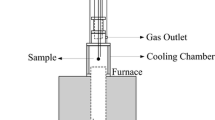Abstract
Experimental measurements are reported on the rate at which commercial grade, low silica hematite pellets react with a gas mixture consisting of CO, H2, and N2 over the temperature range 500 °C to 1200 °C. Systems of this type are of considerable practical interest, both regarding the operation of direct reduction processes and ironmaking in the blast furnace. The results of the work may be summarized as follows: No carbon deposition was found when operating the system above 900 °C and in the absence of CO gas. When operating the system below 900 °C carbon deposition occurred, which in effect prevented the normal conversion from reaching completion. The maximum rate of carbon deposition was found to occur between 500 °C and 600 °C. In general hydrogen (in the presence of CO) tended to promote carbon deposition, while the presence of nitrogen appeared to retard the deposition process. When the reaction process was being carried out below 900 °C with CO + H2 gas mixtures, the reduction process occurred simultaneously with carbon deposition. At lower temperatures, say around 500° to 600 °C, the deposition process dominated, while at the higher temperatures, and particularly at a high hydrogen content of the reactant gas, the reduction process was dominant. The structural examination of the partially reacted specimens has shown that the carbon deposited was found primarily in the form of elemental carbon rather than cementite. Furthermore, X-ray analysis of the free pellet surface has indicated that iron was present in the carbon deposit phase. The practical industrial implications of these findings are discussed in the paper.
Similar content being viewed by others
References
H. Schenck and W. Maschlanka:Arch. Eisenhuttenwes., 1960, vol. 31, pp. 271–77.
E.T. Turkdogan and J. V. Vinters:Metall. Trans., 1974, vol. 5, pp. 11–19.
L. A. Haas, S. E. Khalafalla, and P. L. Weston: U.S. Department of the Interior, Bureau of Mines, Report No. 7064, 1968, pp. 1–29.
I. Gaballah, P. Bert, L. C. Dufour, and C. Gleitzer:Mem. Sci. Rev. Metallurg., 1972, vol. 69, pp. 523–33.
M. Taniguchi, T. Kubo, and I. Muchi:Tetsu-to-Hagané, J. Iron Steel Inst. Japan, 1970, vol. 56, pp. 156–61.
A. Sacco, Jr. and R. C. Reid:Carbon, 1979, vol. 17, pp. 459–64.
N. Towhidi and J. Szekely:Ironmaking and Steelmaking, 1981, vol. 8, p. 237.
J. F. Elliott, M. Gleiser, and V. Ramakrishna,Thermochemistry of Steel-making, Addison-Wesley Publishing Co., Inc., 1963.
R. E. Baron, J. H. Porter, and O. H. Hammond: Chemical Equilibria in Carbon-Hydrogen-Oxygen Systems, The MIT Press Energy Lab., Cambridge, MA, Series, 1976.
Author information
Authors and Affiliations
Additional information
The work was done while Dr. Towhidi was a Visiting Scientist at MIT.
Rights and permissions
About this article
Cite this article
Towhidi, N., Szekely, J. The influence of carbon deposition on the reduction kinetics of commercial grade hematite pellets with CO, H2, and N2 . Metall Trans B 14, 359–367 (1983). https://doi.org/10.1007/BF02654354
Received:
Issue Date:
DOI: https://doi.org/10.1007/BF02654354



